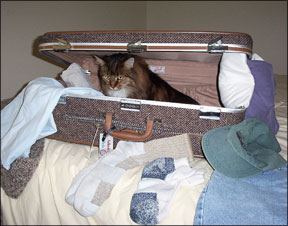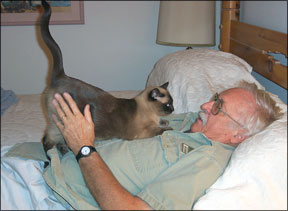Bandit sits on a white plastic grocery sack (with the handles slit so she doesnt become trapped). Sitting on a sack is her persons cue that Bandit wants to play a game. Growltigger sits on papers in front of the computer screen whenever his owner is trying to type. Ziba jumps on newspapers spread out on the dining room table when someone is reading them there. Thomas Mountain Lion Bev Caldwell 288 climbs on bags of recycled paper that make crunching noises when he moves around on them. Place a throw rug on the floor, even if its on top of wall-to-wall carpet, and Migraine will sit on it. Place a folded fuzzy blanket at the end of the bed, and Merry stretches out on it. Stacks of books, stacks of clean clothes, stacks of reports from your tenth grade history class – set them on the floor, and your cat is likely to perch on them. Remember: Cats Are Curious Although these activities may look different, they all have something in common – a cats natural inclination to sit on things whether their owners are involved in using them or not. “When something is new, cats are interested in it,” says Ellen Lindell, VMD, a board-certified member of the American College of Veterinary Behaviorists and a columnist for 
Newness can apply to something brought into the home for the first time, or just something that is novel from your cats perspective, such as a pile of clothing that has just been washed or a throw rug that has been moved from the kitchen to the bath. “Cats investigate something new to see if it belongs,” says Dr. Lindell.
Set a pile of clean clothes from the dryer on the end of your bed, and your cat is likely to camp out on it, whether the stack is still warm or not. “Cats like to rub unfamiliar objects to leave their scent on them,” says Dr. Lindell. “Facial marking makes it smell like them.” If the cat is confident, rubbing satisfies the need. But if the cat is insecure, he may make a stronger statement about ownership by spraying the object with urine.

Bev Caldwell
288
“Each cat is different,” says Dr. Lindell. In addition to smell, the attraction to something new may be due to its texture or the sound it makes when your cat is on it, as in the case of a pile of shredded paper or a crinkly sack. Perhaps its the fact that the object is cat-sized, and the cat feels more comfortable lying on a defined space.
Attention-Seeking Behavior
If your cat involves herself in your work or tries to distract you by sitting on those things you are working on, she is likely a more social cat; having watched you interact with something, she may want to try it herself. “Some cats enjoy what others are doing and are good at observational learning,” says Dr. Lindell.
Not all cats seek out objects to sit on for the purity of the experience, however. Ulterior motives may be at the root of the activity. If your cat sits on the newspaper when you are reading it or the test papers you are grading for your class the next day, she may be trying to tell you something. “Some cats have learned that if they do something to interfere with what you are doing, theyll get attention,” says Dr. Lindell. Providing the attention reinforces your cats behavior. “If they sit on your papers, they will get picked up, if not petted.”
In most instances, cat owners enjoy their cats involvement in what theyre doing. At times, however, we really need to finish those tax returns or complete that report. Simple techniques can help you finish the job and satisfy your cat. Try putting a paper bag, or anything new, down on the floor to draw your cats attention to it.
v


